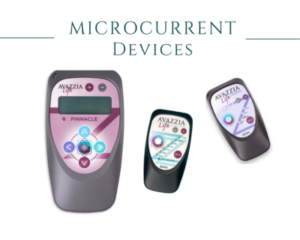
FSM (Frequency Specific Microcurrent) and microcurrent are two popular methods for treating pain and other difficult-to-treat conditions. Both are a form of Energy Medicine, using electrical stimulation to encourage healing. But the two approaches have some important differences. FSM is based on the principle that different frequency currents can target specific tissues and promote healing. For example, low-frequency currents can reduce inflammation, while high-frequency currents can help stimulate cell growth. This approach is often used to speed up recovery from injuries or chronic pain conditions, just like microcurrent. While both FSM and Microcurrent can be effective, choosing the right approach for your individual needs and goals is important.
Today, we’re helping you do just that by explaining the difference between FSM and microcurrent.
FSM vs. Microcurrent
FSM (or frequency-specific microcurrent) is a treatment that utilizes extremely low levels of electrical current. This current is typically delivered through two channels and simultaneously stimulates your body with two different frequencies.
So, how does this differ from our Avazzia devices?
 FSM machines are often large and bulky. They also require you to adjust a variety of knobs and dials to change the current output to your needs throughout treatment. These devices often also require towels and water to conduct the electricity properly.
FSM machines are often large and bulky. They also require you to adjust a variety of knobs and dials to change the current output to your needs throughout treatment. These devices often also require towels and water to conduct the electricity properly.
Our devices operate at a high voltage, which doesn’t mean they’re dangerous (or painful). Because of this, the electrical current gets pushed deeper into the tissue at a depth that FSM can’t offer. It also means that you can work on deeper issues than those on your body’s surface.
The bottom line: Our Microcurrent devices can treat the body while running on algorithms, which automatically change (or modulate) those dials and settings.
As a result, the complexity of FSM is removed!
FSM Research Spotlight:

Results from a 2020 study show that FSM is an effective treatment for pain and disability in patients with lower back pain or neck pain who have been treated by physical rehabilitation.
What Can’t FSM Do?
As the research above demonstrates, FSM has shown to be effective for treating a wide range of conditions, including chronic pain. Microcurrent has also been shown to be revolutionary in treating chronic pain,but that’s not all!
Microcurrent also excels in treating:
- Depression
- Anxiety
- Stress
- Brain Fog
- Poor Vagal tone
- Chronic fatigue syndrome
- Insomnia
And more!
So, while both FSM and Microcurrent are considered safe and effective treatment modalities, it’s important to note that Microcurrent protocols, like those designed by the doctors at Pain Free For Life, are more straightforward, accessible, and, most importantly – more versatile than FSM could ever be.
Microcurrent vs. TENS
If you’re into natural pain resolution, you might have heard of TENS (transcutaneous electrical nerve stimulation) devices. It’s important to note that TENS and Microcurrent technology aren’t the same.
TENS units operate at such high power that they practically paralyze pain pathways to block the pain signal. At first, these pain blocks can feel great, but they’re only temporary. Microcurrent devices, on the other hand, are entirely different from conventional types of electric stimulation. The impulses delivered by Microcurrent are about a thousand times less intense than those provided by a TENS device.
So yes, both TENS and Microcurrent both use electricity to promote healing. But Microcurrent is the only electrical treatment that uses the same range of frequencies as the body (The Schumann Resonances), triggering long-lasting results. Microcurrent devices are also more portable and easier to use than TENS units.
Microcurrent vs. Ultrasound
Microcurrent is a form of Energy Medicine that can break up scarring and inflammation. It can also encourage the production of ATP by up to 500%! Ultrasound, on the other hand, works through vibration but does not provide current nor change ATP status. Ultrasound therapy sends sound waves through the body, which causes cells in your skin to vibrate and release energy that treats inflammation.
Please note that some people find the sound of ultrasound therapy to be unsettling, especially among nerves running near the throat area.
FSM vs. TENS
TENS and FSM are two treatments that use electrical current to promote healing. Although both methods share some similarities, they also have significant differences. TENS is commonly used to relieve pain, while FSM is more often used to improve tissue healing. In addition, the electrical current used in TENS is stronger than the current used in FSM.
TENS is typically used to relieve pain by stimulating the production of endorphins. The electrical current produces muscle contractions, which can help to alter pain signals and reduce discomfort. TENS is often used before chiropractic adjustments, as muscle contractions can help to prepare the body for treatment. In contrast, FSM is not typically used to produce muscle contractions. Instead, the micro amperage current is thought to promote cellular repair and help improve tissue healing.
Microcurrent: The Clear Winner
There are many advantages to using Microcurrent over other forms of electrical stimulation. Microcurrent is gentler and more relaxing than FSM or TENS, and it does not require the use of conductive gel or electrodes. Additionally, Microcurrent is believed to be more effective than other forms of stimulation in promoting healing and reducing inflammation. If you are considering using electrical stimulation for any reason, Microcurrent may be the best option for you.
Sources cited:





